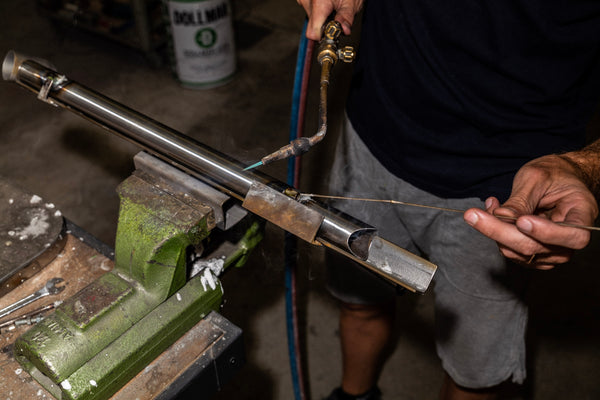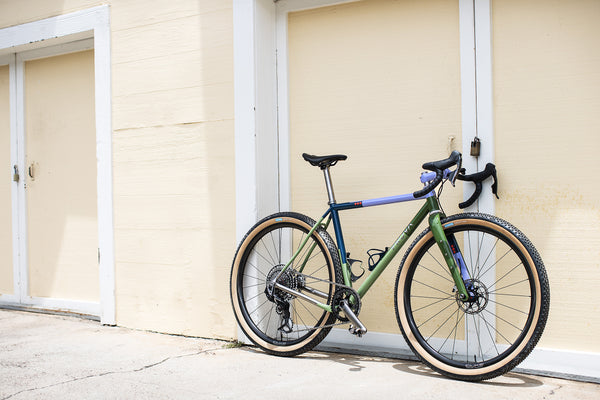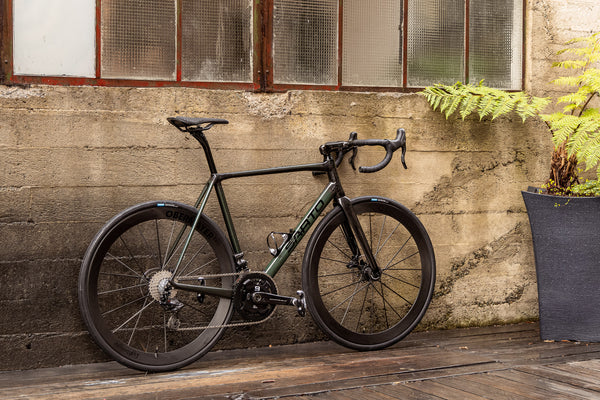If you want to trace the origins of the 'All Road' movement, the bike industry's (occasionally) successful attempts to blend the best of road and gravel bikes into one do-it-all ride, look no further than Jan Heine of Rene Herse Cycles.
Having first coined the phrase back in 2007 to describe the bikes he and his Bicycle Quarterly team were building for themselves, this softly spoken German delights in creating products that push the envelope as far as performance, comfort and ride quality are concerned.
Rene Herse is best known today for its wide all-road, gravel and bikepacking tires, and Jan often mixes it up in gravel races and bikepacking events, setting FKTs and proving the worth of the company's products and ideas in the field.
What's less known is Jan's lengthy road racing background. "Like most of us, I dabbled in racing in college. I won my first race, and things took off from there," Jan explains during our chat about the new Rene Herse tires, the tubeless-specific 700C x 31 mm Orondo Grade.
By the end of his 10-year road racing career, Jan still rode as a privateer while racing alongside American pros preparing for the Tour de France. "I realized that the commitment to compete at that level was 100%, but I had just finished my PhD and needed to think about what to do with my life." At the same time, the lure of long-distance riding proved irresistible. "I've always wondered what lay beyond the horizon." Jan turned to the cross-state races in Washington, one-day 'outlaw' road races over 275 miles or more, where he posted numerous wins and record times. That spirit of finding challenges off the beaten path led to exploring gravel roads, and the rest is history, as they say.

But the road was never far from Jan's heart. In his stable, he keeps his now-classic road bike that he raced for ten years, plus a modern OPEN MIN.D. that he used when developing the new 700C x 31 tire.
For this former technical writer and NASA fellowship recipient, creating a product is an instinctual journey, a lyrical refrain where the process is as much a reward as the goal itself. It's an approach that echoes the diligence and care typically found in Japanese product design and the country where Rene Herse tires come to life. "Working with Japanese companies is fun because they are so proud of everything they do," Jan says. "When they make things, you can tell - there's a unique timbre. And they're uniquely experienced, too. You ask them a question, and they might say, 'Oh, we tried that 20 years ago, and it didn't work so well.' Going there and talking to them is enjoyable because you often talk to people who have been with the company for decades. That long view is priceless. But they're still curious about the new ideas we bring them. Our science background and the experience of professional riders like Ted King and Brennan Wertz, with whom we work closely in our R&D, allow us to test prototypes and ideas quickly. This then forms the basis for products that work in the real world, not just in a testing lab."
Here's our Q&A with Jan about the new Orondo Grade road tire.
Hey Jan, what's the new rubber all about?
The new 700C x 31 Orondo Grade is our first tubeless-compatible road tire for high pressures. Our all-road tires are also tubeless-compatible, but you wouldn't run them at high pressures like a pure road tire.
Why road tubeless, and why now?
Tubeless is an excellent choice for many riders, but most tubeless road tires don't offer the supple comfort and speed riders love in our Rene Herse tires. There is a reason for this: It's easy to make a tubeless-compatible tire using a stiff casing covered with lots of rubber. With the supple, thin casing of a true high-performance tire, high pressures can push sealant through the casing. To make the tire airtight, you need a liner, but most liners make the tire a lot stiffer and heavier - the opposite of what we are looking for with our supple and fast Rene Herse tires.
We've gone through many prototypes tested for performance, durability, and feel - on the road, where it matters. We're now confident we can offer a tubeless-compatible road tire without giving up the comfort, speed, and ride feel that our Rene Herse tires are famous for. And it's rated to a maximum pressure of 90 psi - plenty even for heavier riders.
What are the advantages of tubeless vs running a tube, and how has the tech reached a point where tubeless should now be on everyone's radar?
For gravel and bikepacking, tubeless eliminates pinch flats, so it's an important tool, especially for racers in the big races. When you're riding in a large pack and can't see the road ahead, you're hitting rocks you would otherwise ride around. Tubeless adds some insurance against pinch flats.
On the road, the sealant inside tubeless tires can seal small punctures. That's a big plus for many riders. The drawback of tubeless is that you need to maintain the sealant inside; otherwise, it dries out, leaving your tire with a block of latex and no liquid sealant. With our new Orondo Grades, we've also tested them by leaving them standing for a month with a minimum of sealant and then checking that the sealant hadn't dried out - that's how airtight they are, even in the Extralight casing.

What did you bring to this tire that you didn't see or experience elsewhere?
We just hadn't found a tubeless-compatible road tire that matched a top-end tubular's speed, comfort and ride feel - and that's the benchmark for all our tires. So we decided to create that.
We're also offering the new tire in the Endurance casing, which is much faster and more comfortable than other puncture-resistant tires. That makes the Orondo Endurance an excellent choice for riders on road bikes who ride in environments where flat tires are a concern.
Were there any notable challenges in bringing the tire to life?
We never make anything that others already offer because we prefer to pour our limited resources (we're a small company) into addressing some genuine needs for our own riding. So all our products break new ground in some way or other. With the Orondo Grade tires, we faced a number of issues. There's a new bead material to make supple tires suitable for high pressures. Finding the right liner - airtight without being stiff and slowing down the tire - was another challenge.
How did you go about testing the tire?
You'll laugh, but we wanted to keep this project under wraps, so the real road testing was mainly done at night. We've got some steep hills in Seattle, and my preparation for races like Unbound XL and events like Paris-Brest-Paris includes a lot of interval training. Several times a week, I'd head out in the dark, ride across town, and sprint up a 20% hill to subject the tire casing to high power (600+ Watts) while the bike also faced high resistance due to the steep slope. Then I'd descend another, equally steep hill on cobblestones, with a stop sign at the bottom. The sound of my front tire chirping as it lost (and regained) traction on the cobbles under hard braking became all too familiar. These two tests stressed the casings to the max and gave us confidence the tires would withstand even hard riding with high power outputs. There were a lot of other tests - rolling resistance, ease of mounting and taking off various rims, etc.

The tire is available in Rene Herse's usual casing options, right? And if so, can you talk about the suitability of each casing for certain conditions?
Yes, we're offering the Orondo Grade with the Standard, Extralight and Endurance casings. No Endurance Plus - that's intended for off-road courses full of sharp rocks, for which you'll want wider tires than the Orondo.
The Standard casing is our more affordable option: comfortable, fast, yet strong enough to withstand considerable abuse. The Extralight casing takes the bike's performance, comfort and feel to an entirely new level. If you love the ride of a top-level tubular, you'll love the Extralights. The Endurance casing is reinforced for extra sidewall protection and puncture resistance while retaining high levels of speed and comfort. Gravel racers like Ted King and Brennan Wertz usually choose the Endurance casing for big races, but it's equally at home on the road for riders who tend to have a lot of flats.
You've touched on this before, but do you see a new width 'standard' emerging in the road world? We have been at 28 as the new' 25' for a few years - are we looking at a future of 30+?
At Rene Herse, we've been promoting wider tires for decades, based on our testing that shows that 31s are as fast as 25s. It's been good to see the pros go wider and wider. I think many pros will run 30-31 mm in coming years - some, like Pogačar, already do. It just makes so much sense: With 31s, you get a ride that keeps all the positive attributes of a road bike while filtering out all the harshness.
If someone hasn't ridden tubeless before, do you have any tips regarding sealant, set up, and, if a puncture happens, how to handle it - or does the tire pretty much 'reseal' itself?

Tubeless setup mainly involves getting the sealant into all the gaps between tire and rim. That's a lot harder with supple tires because they are so flexible that there can be tiny gaps between the tire bead and the rim.
As to going about it correctly, first, ensure the tire is seated perfectly. Inflate to the maximum pressure of the tire or rim (whichever is lower) to really push the rubber against the rim. Then, distribute the sealant so it reaches every part of the tire/rim interface. Some mechanics bounce the wheel like a basketball at this point, turning it a bit with each bounce. I usually raise the wheel over my head quickly and then let the sealant run into the tire/bead interface. Turn the wheel a fraction, and repeat.
If a puncture happens and you hear air escape, rotate the wheel until the puncture is at the bottom and wait for sealant to come out. This should seal itself. If not, you'll have to install a tube. (Always carry a tube, tire levers and a small pump, just in case.) Also, ensure you have enough sealant in your tires and that it's still liquid. It's not just that a puncture won't seal, but the tire always works a bit against the rim, and if there's no sealant to constantly seal it, it can suddenly break loose and deflate.
All your tires are named after the places that inspired them. Where is Orondo Grade?
Orondo Grade is a 7-mile 10% climb up a side canyon of the mighty Columbia River. It's a beautiful place and a very tough climb. At the top is Waterville, the highest town in Washington State. The Orondo Grade was the halfway point of the now-defunct 285-mile cross-state race, S2S (Seattle-to-Spokane). That was back in the pioneering days of long-distance racing, and I rode on 21.5 mm tubulars in that annual race. Now I wish I had the extra cush and speed of wider tires back then. The new Orondo Grades would have been perfect.
What's your favorite casing for the new tires?
I love the Extralights. I run them on all my bikes, in most terrain, even the ultra-rocky Arkansas High Country Race. Only in Unbound XL did I choose the Endurance to deal with the Flint Hills of Kansas. But every rider is different. That's why we offer three different casings for the Orondo Grades. Choose the tire that matches your riding style and your terrain.










Back to Journal